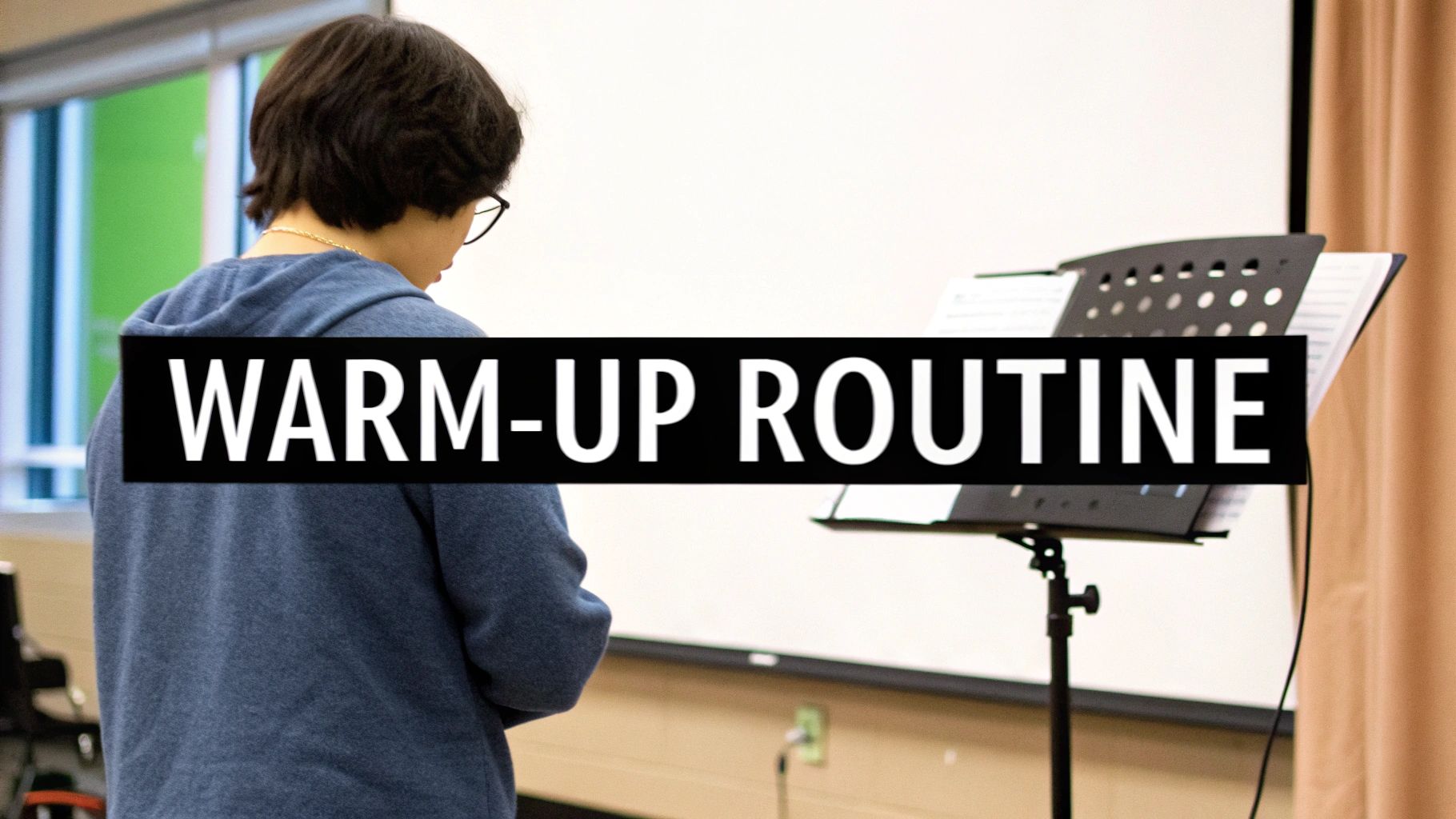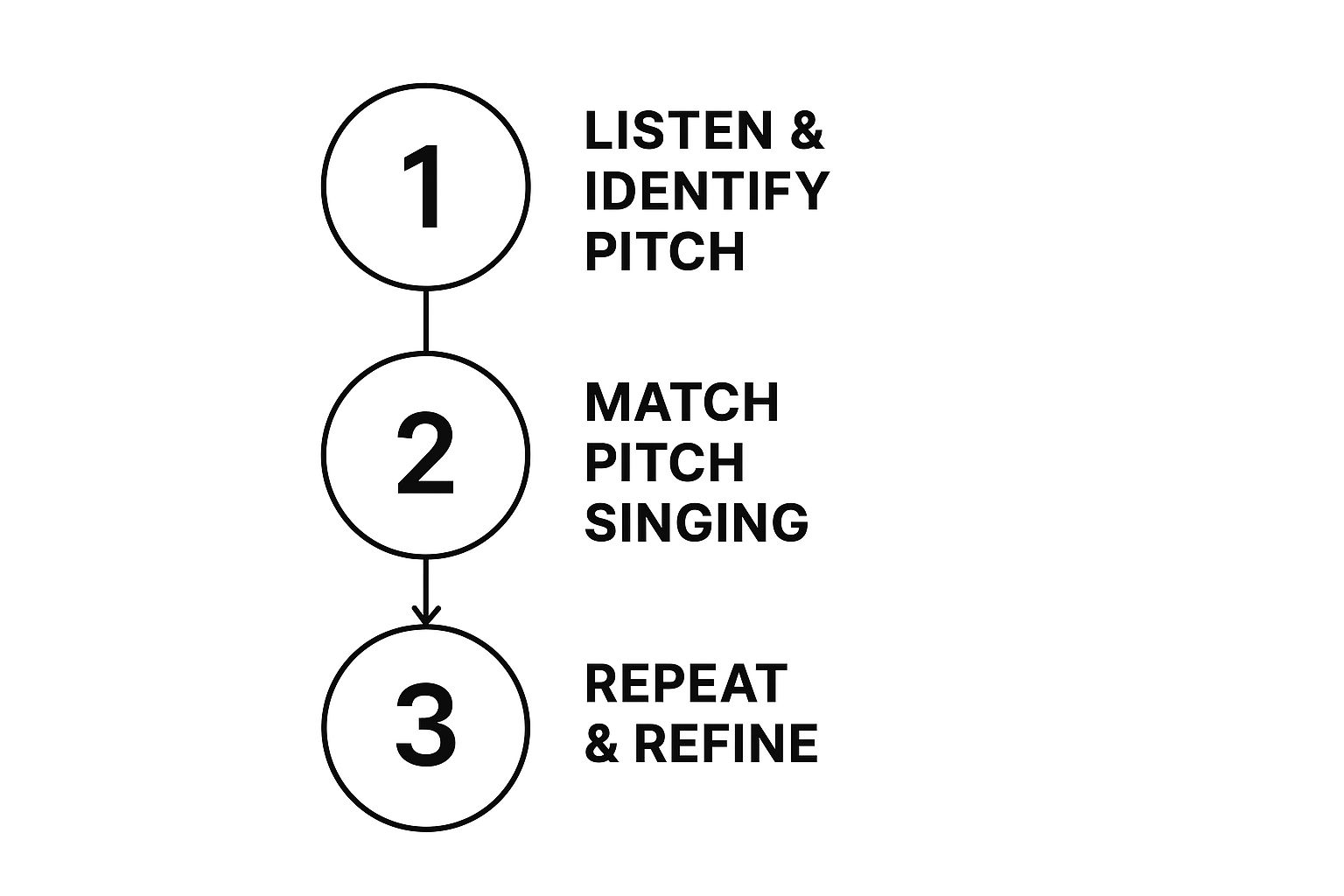A Practical Guide on How to Sing in Tune
Struggling with pitch? Learn how to sing in tune with proven exercises, ear training, and pro tips to finally build your vocal confidence and accuracy.
Posted by
Joe BrewerRelated reading
Unlock Music Theory Fundamentals Today
Your journey to understanding music starts here. Our guide makes music theory fundamentals easy, with clear explanations on scales, chords, rhythm, and more.
How to Hear Chord Changes Like a Pro Musician in 60 Seconds
Learn how to hear chord changes easily with our expert tips. Improve your musical ear today and master listening skills like a professional!
Can You Learn Perfect Pitch? Discover the Truth Today
Wondering can you learn perfect pitch? Explore the science, adult training tips, and how relative pitch plays a role.
A Practical Guide on How to Sing in Tune
If you’ve ever felt like hitting the right notes is an impossible dream, I'm here to tell you it's not. So many singers start out feeling that way. But singing in tune isn't some magical talent you're born with—it's a physical skill. It’s all about creating a strong connection between your ears, your brain, and your voice. With the right approach, it's a skill anyone can build.
Why Singing in Tune Feels So Hard (And Why It Isn't)

Before we get into the practical exercises, let's pull back the curtain on why singing in tune can feel so incredibly frustrating. For almost everyone, singing "off-key" isn't because you're "tone-deaf." It's usually just a simple disconnect in the system.
Think about learning to throw a ball. Your first few throws probably missed the mark because your brain was still learning how to command your arm muscles with precision. Singing is no different. Your brain has to learn how to give your vocal cords the exact instructions they need to create the pitch your ears are hearing.
The Real Hurdles to Accurate Pitch
So, what causes these disconnects? From my experience, they almost always boil down to three things: how you hear, how you produce the sound, and how you think about it all.
Auditory Perception
Sometimes, the root of the problem is in how you're hearing the note. But more often than not, the issue is with hearing yourself accurately. The voice you hear inside your own head sounds completely different from what everyone else hears, thanks to bone conduction. This is a huge hurdle for many new singers.
Vocal Production
This is all about the physical stuff. Tension is the number one enemy of good pitch. If your jaw, neck, or throat are tight, they're literally strangling your vocal cords, stopping them from vibrating freely and hitting the note cleanly. Poor breath support is another huge factor—without a steady, controlled stream of air, notes will waver and fall flat.
Psychological Blocks
Ever heard of a self-fulfilling prophecy? The fear of singing a wrong note can make it happen. When you feel anxious or self-conscious, your whole body tenses up. That tension directly impacts your vocal muscles, making it nearly impossible to sing with control and accuracy.
To really sing in tune, you need a combination of skills working together. This isn't just about your vocal cords; it's about your ears, your breath, and your mind.
The Core Components of Singing in Tune
| Skill Component | Description | Key Focus Area |
|---|---|---|
| Auditory Acuity | The ability to accurately hear and identify a pitch. | Ear training, active listening to music and your own voice. |
| Vocal Coordination | The brain's ability to send precise signals to the vocal cords. | Pitch matching exercises, scales, and sirens. |
| Breath Support | Using the diaphragm to provide a steady, controlled airflow. | Breathing exercises, sustaining notes without wavering. |
| Relaxation | Releasing physical tension in the jaw, throat, and shoulders. | Body awareness, stretching, and mindful practice. |
Each of these components is a skill you can train. By focusing on them individually, you build a strong foundation that makes singing in tune feel less like a mystery and more like a predictable outcome.
Don't just take my word for it. Research shows that while genetics play a part—accounting for about 40.7% of pitch accuracy—the vast majority comes from training and environment. You can read the full study on the genetic and environmental impacts on singing.
This is fantastic news! It means your exposure to music, your practice habits, and your dedication matter more than anything else. You are in the driver's seat.
The most powerful thing you can do right now is to reframe the challenge. Stop thinking, "I can't sing in tune." Start thinking, "I am learning to coordinate my voice with my ear." This simple mental shift turns an impossible goal into an achievable skill, built one exercise at a time. This guide will give you those exact steps.
Get Your Body Ready: Posture and Breath are Everything
Before a single note even leaves your lips, we need to talk about your instrument. And no, I don't mean a guitar or a piano—I mean you. Your body is the entire support system for your voice, and if it isn't set up correctly, singing in tune becomes an uphill battle.
Think about it: slouching crushes your diaphragm and puts a ton of tension in your neck and shoulders. That tension travels straight to your vocal cords, choking off your sound. The result? A shaky, weak tone that’s nearly impossible to control. A solid foundation starts with posture and breath.
First, Straighten Up
Getting your posture right is simpler than you might think. It’s all about creating a clear, open path for air to flow.
Stand with your feet about shoulder-width apart, with your weight feeling even and grounded. Now, imagine a string is gently pulling the very top of your head toward the ceiling. This simple thought helps lengthen your spine without making you feel stiff or robotic. Let your shoulders relax down and back, away from your ears.
Here's a classic trick voice teachers use to help singers feel this alignment:
- Try balancing a light book on your head. Walk around the room for a minute. To keep it from falling, you’re forced to engage your core and maintain that long, straight spine.
- While you’re at it, consciously unclench your jaw. A tight jaw is a voice killer and a super common habit that sabotages pitch.
This isn’t just for show. This alignment is a physical prerequisite for producing a clear, stable sound you can actually guide.
Breathe From Your Belly, Not Your Chest
With your body aligned, let's focus on the fuel for your voice: your breath. If you’re like most people, you probably breathe into your chest. For singing, that’s a problem. Chest breathing is shallow and doesn't give you the power you need.
You want to breathe from your diaphragm, that big dome-shaped muscle right below your lungs.
Why This Matters: Breathing with your diaphragm gives you a steady, pressurized stream of air to support your vocal cords. Without that consistent support, your notes will almost certainly go flat, especially as you try to hold them at the end of a line.
A fantastic way to feel this in action is with a simple hissing exercise.
- Breathe in deeply and silently. Focus on letting your belly expand outward, like you’re inflating a balloon in your stomach. Your chest and shoulders should stay relatively still.
- Now, release the air on a long, slow "ssssssss" sound.
- The goal is to keep that hissing sound completely steady and even for as long as you possibly can. No sputtering, no bursts of air.
This exercise is pure gold. It trains your abdominal muscles to manage air pressure, which is precisely what you need to do to hold a sung note without it wobbling or dying out. Nail your posture and your breathing, and you’ve already won half the battle of singing in tune.
Train Your Ear to Hear Pitch Like a Musician

It’s an old saying, but it’s true: you can't hit a target you can't see. For singers, the same logic applies. You can't sing a note you can't accurately hear. Developing a "good ear" isn't just a part of the process; it's arguably the most critical step in learning how to sing in tune.
This is all about forging a rock-solid connection between your mind and your ears. When you hear a melody, your brain needs to know exactly what those pitches are. The best part? This is a skill you can build. It has far less to do with innate talent than it does with intentional practice. Let's start with the most basic building block of all music: a single note.
Start by Matching a Single Pitch
Before you can tackle complex melodies, you have to be able to hear one note and replicate it perfectly with your voice. The best way to do this is with a reliable reference pitch. Grab your phone and download a keyboard app, use a free online tuner, or sit down at a real piano if you have one.
First, play a single note that feels comfortable in your voice—middle C is often a great starting point. Really listen to it. Don't just hear it; try to feel where it sits in your head and chest. Is it high? Low?
Now, gently hum that note back. A relaxed "hmmm" or "ahhh" is all you need. We're not going for power here, just pure accuracy.
How do you know if you nailed it? Use a chromatic tuner app on your phone. It gives you instant, unbiased feedback. The tuner will tell you if you are sharp (a bit too high), flat (a bit too low), or right on the money. If you're off at first, don't sweat it. That feedback is your roadmap. Nudge your pitch up or down until the tuner gives you the green light. Do this over and over with different notes to build that crucial muscle memory.
Learn to Hear the Gaps Between Notes
Once you're feeling good about matching single notes, it's time to recognize the space between them. These distances are called intervals, and they are the DNA of every melody you've ever heard.
The secret to making intervals stick is to connect them to songs you already know. This turns a boring, technical exercise into something you can actually remember and use.
Here are a few common intervals to get you started:
- Minor Second (one half-step): The tense, back-and-forth notes from the Jaws theme.
- Major Second (one whole step): The first two notes of "Happy Birthday" (on the words Ha-ppy).
- Perfect Fourth (five half-steps): The classic opening phrase of "Here Comes the Bride."
- Perfect Fifth (seven half-steps): The heroic, leaping notes that open the Star Wars theme.
- Octave (twelve half-steps): The big jump in "Somewhere Over the Rainbow" (on Some-where).
The ability to identify intervals by ear is a cornerstone of musicianship. It's the difference between guessing where a melody goes and knowing where it goes. This skill directly translates into your ability to sing in tune, especially when navigating tricky melodic leaps.
Try playing these intervals on a piano. Then, sing them, using the song hooks as your guide. Before you know it, you'll start hearing these melodic "shapes" everywhere.
Turn Passive Listening into Active Training
Finally, you can sharpen your ear just by changing how you listen to music every day. It's time to stop letting your favorite songs be background noise and start engaging with them like a musician.
Next time you put on a song, get curious. Ask yourself a few questions:
- Is the singer's melody moving up or down?
- Are the jumps between notes small and stepwise, or are they big leaps?
- Can you pick out the bassline and try humming it?
Challenge yourself to sing the main melody along with the track, then try it without the singer's voice as a guide. This kind of active listening is one of the most powerful things you can do to sharpen your pitch perception and truly internalize what it means to sing in tune.
Getting Your Voice to Hit the Mark: Practical Exercises
Okay, so your ear is starting to get the hang of this pitch thing. Fantastic. Now comes the real work: getting your voice to cooperate. This is all about building that mind-body connection, turning the pitch you hear into the note you sing. The trick is to start small and build up, focusing on coordination without straining your voice.
Think of it this way: you wouldn't learn to juggle by starting with flaming torches. You'd start with a single ball, getting a feel for the weight and the motion. Singing is no different. We'll begin with some gentle exercises to get your voice moving freely before we start aiming for specific targets.
Start with Gentle, Playful Warm-Ups
Before you even think about hitting a perfect note, you need to get your vocal instrument warmed up and ready to go. These exercises are incredible for exploring your range and waking up your vocal cords without the pressure of being perfectly in tune.
- Lip Trills (or "Lip Bubbles"): This is a non-negotiable for singers at every level. Loosen your lips, press them together gently, and blow air through them to make that classic "brrrr" motorboat sound. While you're doing that, slide your voice up from a low note to a high one and back down again, like a siren. This simple action does wonders for releasing tension in your face and jaw while encouraging a steady, supported breath.
- Humming Sirens: This is a similar concept, but it helps you feel the sound in your body. Start a gentle "hmmm" and slide your voice up and down your range. The goal is a smooth, unbroken sound—no cracks or sudden jumps. Pay attention to the vibrations you feel in your face, chest, and head. This builds a physical awareness of how your voice resonates.
Seriously, don't skip these. I’ve seen seasoned pros use these exact warm-ups every single day to keep their voices agile and responsive.
Time to Zero In on Accuracy
With your voice awake and flexible, it’s time for some target practice. This is where you'll grab your piano, keyboard, or a reliable tuner app to give you a clear reference pitch. The name of the game here is mindful, deliberate repetition.
A great place to begin is with a simple major scale. But don't just blast through it. Play the first note on your instrument. Really listen to it. Then, sing that note back on a neutral vowel, like "ah" or "oo." Check your tuner. Are you sharp? Flat? Dead on? Don't move to the next note in the scale until you’ve matched the first one. This slow, intentional process is what builds the muscle memory your vocal cords need to find the right notes instinctively.
It's really a simple, three-part cycle you're trying to master.

You hear the note, you sing the note, and then you adjust based on what you hear. That last part is the most important.
My Biggest Piece of Advice: Record yourself. Always. The secret to fixing your pitch isn't just more singing; it's more listening. When you're in the moment, your brain can play tricks on you, but a recording doesn't lie. It gives you objective, honest feedback and will help you spot patterns you’d otherwise miss, like a tendency to always go a little sharp on high notes.
This kind of analysis is incredibly powerful. For example, large-scale studies of music show that pop—which accounts for 74.37% of recorded singing globally—is often fast. In fact, 42.67% of pop songs have a fast tempo, which makes landing each note precisely much more difficult. By recording your practice, you can hear exactly how you handle those quick passages. If you're curious, you can discover how musical trends impact vocal performance and see more fascinating data on how people sing around the world.
Let Technology Be Your Guide

As you work on your pitch, you've got an incredibly powerful coach sitting right in your pocket. Your smartphone can give you the kind of instant, unbiased feedback that used to require a private instructor, helping you make progress much faster.
This isn't about finding a magic bullet or a crutch. It's about practicing smarter. A simple chromatic tuner app is one of the most powerful tools you can add to your arsenal. The visual display gives you a clear, real-time report card on your pitch accuracy.
Precision Practice With a Tuner App
A tuner app is your personal pitch trainer. It doesn't just give you a pass/fail grade; it shows you the degree to which you're sharp or flat. That visual data is invaluable for training your voice to make those tiny, crucial adjustments on the fly.
Instead of just checking a note here and there, turn it into a focused exercise:
- First, choose a note that feels easy and comfortable in your range. Sing it on a sustained "ahhh."
- Now, look closely at the tuner's display. Is the needle perfectly still on the target, or is it flickering back and forth?
- Your mission is to hold that needle steady in the green "in-tune" zone for at least five seconds.
This simple drill does more than just check pitch; it actively trains the muscles that control your breath support and vocal stability. Hitting a note is one thing, but sustaining it with accuracy is what allows you to sing musical phrases beautifully.
Once you get the hang of that, start using the tuner to walk you through scales. Sing each note slowly and deliberately, waiting for the tuner to confirm you're on target before you move to the next one. With every repetition, you're building solid muscle memory and strengthening that vital connection between your ear and your voice.
A Quick Word on Pitch Correction Software
Of course, you can't talk about modern singing without mentioning tools like Auto-Tune. This software has been a defining force in the sound of pop music since the late 1990s, giving producers the ability to polish vocals to a perfect shine. Its use even became a hot-button issue, with shows like 'The X Factor' sometimes banning it to ensure they were hearing raw, natural talent. You can read more about the cultural impact of Auto-Tune.
The way this software functions is insightful. It listens to a singer's pitch and automatically shoves any wayward notes to the closest correct semitone. While it’s a standard tool in the studio, it highlights the very thing we’re striving for: natural, unaided pitch accuracy.
Our goal isn't to depend on software to clean up our mistakes later. It's to train our bodies to produce the right notes from the very beginning. Using a tuner app during your practice sessions is how you build that authentic skill. It gives you the raw data needed to adjust your technique in the moment, making you a fundamentally better and more reliable singer—no post-production required.
Common Questions About Singing in Tune
https://www.youtube.com/embed/YCLyAmXtpfY
When you start digging into a new skill like singing, it's natural for questions to bubble up. In fact, that's a great sign—it means you're engaged and really thinking about what you're doing. Let's tackle some of the most common questions that pop up on the journey to singing in tune.
How Long Does It Take to Learn to Sing in Tune?
This is the big one, isn't it? The honest answer is: it depends. Your timeline is shaped by your starting point, how often you practice, and—most importantly—the quality of that practice.
Think consistency over intensity. You’ll see far more progress with focused daily practice of just 15-30 minutes than you will from a long, grueling session once a week. With that kind of regular, mindful work on ear training and pitch exercises, most people start hearing and feeling a real difference within a few months.
It's all about building that muscle memory, one day at a time.
Can I Learn if I'm "Tone-Deaf"?
Let's clear the air on this one. The chances of you being genuinely tone-deaf are incredibly slim. True clinical tone-deafness, or amusia, is a neurological condition that affects only about 1.5% of the population.
For almost everyone else, feeling "tone-deaf" isn't a permanent state. It’s just an untrained ear.
Most singers who believe they're tone-deaf are just experiencing a lack of coordination between what their ear hears and what their voice produces. It's a skill gap, not a life sentence.
The ear training exercises in this guide are designed specifically to build that connection. You're literally forging new neural pathways. Trust the process, and you'll be amazed at what your ears and voice can learn to do together.
Why Do I Always Sing Flat or Sharp?
If you notice you're consistently missing notes in the same direction—either too low or too high—don't get discouraged. This is actually fantastic feedback! It points to a specific, fixable habit.
-
Consistently Singing Flat (Too Low): Nine times out of ten, this is a breath support issue. Your voice isn't getting a steady, energized stream of air, so the pitch sags underneath the target. The fix? Go back to your diaphragmatic breathing exercises. Focus on creating a solid, consistent foundation of air for every note.
-
Consistently Singing Sharp (Too High): This is usually a tell-tale sign of tension. When you strain to hit a note, your jaw, neck, or throat muscles tighten up, squeezing your vocal cords and pushing the pitch too high. The solution here is to focus on relaxation. Drop your jaw, release any tension, and let the sound flow easily instead of forcing it.
This is where technology becomes your best friend. Recording yourself and using a pitch tuner app will give you undeniable proof of your tendencies. Once you know if you're pulling sharp or dropping flat, you can focus your attention on fixing the root cause—whether it’s breath or tension. This is how you stop making the same mistake and start singing with accuracy.